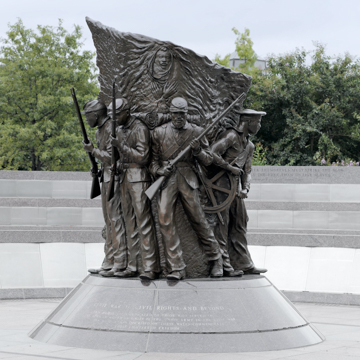The African American Civil War Memorial is located in the Shaw neighborhood, at the intersection of U Street and Vermont Avenue in Northwest Washington, D.C, across the street from the African American Civil War Museum. It is the first memorial honoring the 209,145 soldiers of the U.S. Colored Troops who fought in the Civil War. President Abraham Lincoln formed African American regiments in 1862 to gather more troops and also generate support for abolition efforts. Enslaved, formerly enslaved, and free African Americans volunteered to join the regiments.
The $2.6 million memorial was financed by a private foundation and built by the city's Department of Public Works. Ed Dunson and Associates planned the unusual, triangular plaza, while the Memorial itself was designed by Devrouax and Purnell Architects-Planners, both firms headed by African American designers. The memorial comprises two semicircles, one nesting inside the other. At the center is a 9-foot-tall bronze statue, The Spirit of Freedom, created by Ed Hamilton of Louisville, Kentucky. It features four Army and Navy men in uniform on one side, holding their shotguns and standing in front of a flag-shaped form that represents freedom; on the opposite side, the sculpture features a family with women and children seeing a soldier off to war, thus signifying the sacrifices made by African American communities at large. The curved panels are inscribed with the names of the men who served in the conflict. Hamilton commented on his design: "My hopes were to create a piece that spoke to the honor of the soldiers, as well as the sailor, but to really bring it on home as you walked around and viewed the names, and when you got to the back side of those names, all of a sudden you look up and there was this family." The memorial was dedicated in 1998.
Merely five years after the project's completion, the Department of Public Works had failed at maintaining the memorial. Critics commented that the memorial's rapid deterioration was in part due to the original design: for example, the plaques with soldier names never fit quite right and were hard to read. In 2016, thanks to crucial updates and pressure from the public, the National Park Service accepted the memorial and now manages the site. The memorial and museum's placement opposite the U Street Metro Station is significant in that it further contributes to the ongoing gentrification of the area and efforts to draw tourism to this neighborhood.
References
"African American Civil War Memorial." NPR's Morning Edition, July 17, 1998.
"African American Civil War Memorial and Museum, African American Heritage Trail." Cultural Tourism DC. Accessed March 28, 2020. https://www.culturaltourismdc.org/.
Jacob, Kathryn Allamong. Testament to Union: Civil War Monuments in Washington, D.C. Baltimore: Johns Hopkins University Press, 1998.
Wheeler, Linda. "African American Civil War Memorial is Modern Battle Casualty." Washington Post, August 15, 2002.














